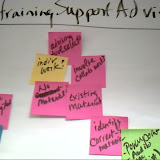Don’t Box Me In!
Performance Centered Design
User Centered Design
Usage Centered Design
We have learned about all of these design methods in our efforts to understand the intricacies of instructional design and development. All are so similar and yet so different (according to those who have originated these concepts). Understanding personas to model the preferred user experience, scenarios to model task flow, and essential use cases to get down to the basic user/system interaction is enough to make your head spin. Our advisor wants us to employ usage centered design as we try to map out the Virtual Collaboration Center interface. The team is having difficulties conceptualizing this extremely abstract process. According to Constantine and Lockwood (1999), originators of this method, a use case “describes interaction independent of implicit or explicit assumptions regarding the technology or mechanisms of implementation” (p. 107). This means we shouldn’t have tunnel vision by letting technology cloud our vision during design. Otherwise, you may end up trying to push a square peg through a round hole. But the team still wants to frame these use cases in terms of available technologies because this process is so abstract, we are searching for some definition, some boundaries to work with. I think it is almost akin to being in a well lit, yet windowless room when suddenly the power goes out. It is pitch black, and what do you do? Immediately identify the nearest wall and follow it around to the nearest door.
As I worked on the use case that I needed to develop, I have thought a bit about Keepon. This innovative little robot was created specifically for kids with developmental disorders such as autism. It’s basic design seems to me like an example of usage centered design. Whether that technique was employed in the creation of Keepon, who knows, but I can see where identifying essential use cases could have been integral in the design and development in this simple and extremely effective robot. Another thing I like about Keepon -- he is a viral and music video star!
References
Constantine, L. L., & Lockwood, L. (1999). Software for Use: A Practical Guide to the Methods of Usage-Centered Design. Reading, MA: Addison Wesley Longman, Inc.




1 comment:
Just thinking of you. Hi friend!
Post a Comment